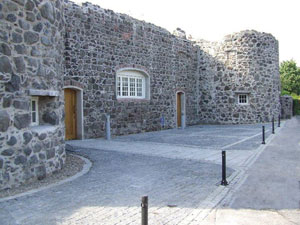 In 2006 the White House at Newtownabbey featured in the BBCís Restoration programme. It did not win, but interest in the project to restore the building was generated. Bangor Historical Society members visited the site on 13 October and were able to see the great progress which had been made. The Trust which oversaw the project received support from the Heritage Lottery Fund and bodies such as Newtownabbey Council. A total of £1.2 million was spent. As well as welcoming visitors, the building is used by groups such as the local historical society.
In 2006 the White House at Newtownabbey featured in the BBCís Restoration programme. It did not win, but interest in the project to restore the building was generated. Bangor Historical Society members visited the site on 13 October and were able to see the great progress which had been made. The Trust which oversaw the project received support from the Heritage Lottery Fund and bodies such as Newtownabbey Council. A total of £1.2 million was spent. As well as welcoming visitors, the building is used by groups such as the local historical society.
Photo at right is copyrighted by Antrim & Newtownabbey Borough Council.
The White House consists of a fortified farmhouse or bawn with flanking towers. It was once covered in limestone, which gave rise to its name. It is thought that a wooden farmhouse was erected during the reign of Henry VIII. Elizabeth I gave the land to an English soldier called Major Brunker. In the early seventeenth century the stone building was constructed.
The White House is best known for its connection with the Glorious Revolution in Ireland in the late seventeenth century. We were given a guided tour of the displays which show the story. In 1689 William IIIís general, Schomberg, landed on the south coast of Belfast Lough and marched round the head of the lough towards Carrickfergus. He then went south as far as Dundalk, but after losing many of his soldiers to disease he returned north, making the White House his headquarters. In 1690 William III landed at Carrickfergus, bringing many reinforcements. It is thought that 500 sailing ships lay in the Lough opposite the White House and troops disembarked and camped nearby. The building of the M5 means the White House is no longer as close to the shore. William met Schomberg, although it cannot be proved that he actually stayed at the White House. Later William, Schomberg and their soldiers headed south to the Boyne where they defeated the forces of James II. Schomberg was killed in the battle.
Subsequently the house had various owners and its condition deteriorated. From 1920 it was used as a gospel hall. In 1997 the congregation built a new meeting house nearby. In 2000 the White House Preservation Trust was set up to preserve and restore the building. The work on the house had to be carried out using appropriate materials, including limestone. There were gunloops in the walls, but only one is now open. Remains of a bread oven can now be viewed though a glass wall. Other displays include costumes and a painted reconstruction of the house and its surroundings.
During this restoration finds ranged from prehistoric flints to a coin of William and Mary.
After the tour we adjourned to the tearoom for refreshments. We then saw an excellent DVD telling the story of the Glorious Revolution. The White House is open to visitors and welcomed its 2,000th one in July. School groups have also visited the site. Further information on the buildings is available on the Trustís website.
